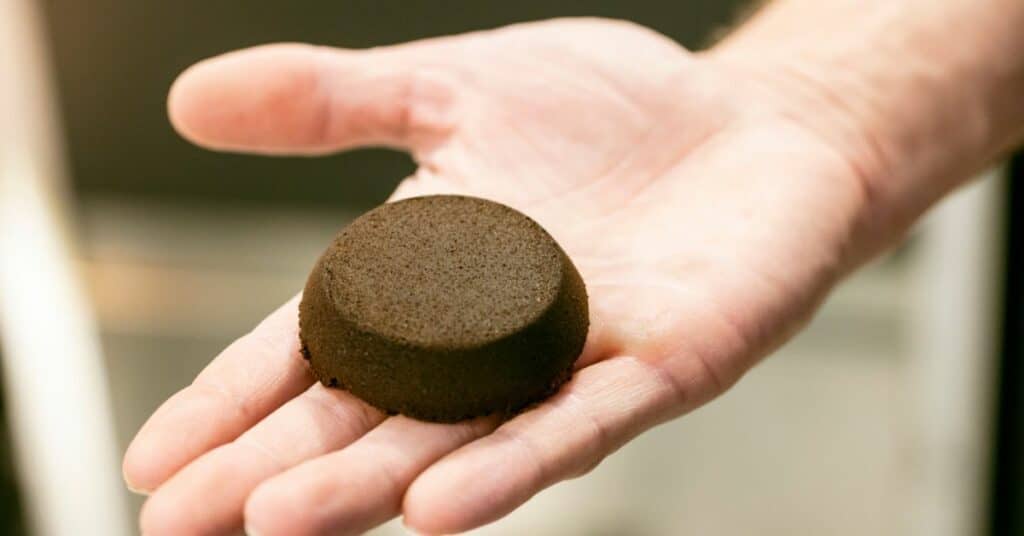As an espresso enthusiast, I want to know as much as possible about brewing. That includes espresso pucks. Hence, I wrote this guide.
The following guide will explain what espresso pucks are and how they’re made. I’ll also discuss the importance of different actions throughout the brewing process.
Here is an overview:
Let’s dive in.
Key Takeaways
- Espresso pucks are compacted coffee grounds in a portafilter.
- Repurpose espresso pucks by using them as fertilizer.
- Store coffee grounds in an airtight container to keep them fresh.
- Use espresso puck screens to help eliminate espresso channeling.
What an Espresso Puck is & Puck Size

An espresso puck is the compacted coffee grounds that remain in the portafilter after a pulled espresso shot. It is typically a 1-inch thick puck of coffee grounds.
A well-made espresso puck is essential for a good espresso shot. To ensure smooth brewing, you must evenly distribute your coffee grounds within the puck.
If you fail to distribute coffee grounds evenly, you’ll have air pockets or an uneven grounds surface [1]. Both mistakes will lead to espresso channeling, which will result in bad-tasting coffee.
Look into a guide we wrote about espresso channeling. We explain what it is and how to prevent it.
What to do with Espresso Pucks
Most folks will dry out the espresso pucks and throw them in their gardens to fertilize plants [2]. However. Espresso pucks are acidic; you shouldn’t mix them with plants that need higher pH soil.
I did this a lot in the past and ended up killing plants. Don’t make the same mistake. Research whether your plants thrive in acidic soil.
Do you have a lot of coffee grounds saved up? Ask a neighbor or friend if they need it for compost. I frequently see coffee shops giving out free used coffee grounds to the public for such a purpose.
Or place them in a bowl and your refrigerator or freezer. Coffee grounds make for great deodorizers and can help eliminate nasty smells while making your appliances smell like coffee shops.
Other folks say to use it as a cleaning scrub, insect repellant, or fabric dye. They’ll scratch your skin when used as a scrub and don’t work well as a bug repeller—in my experience. However, I’ve never used them as a fabric dye.
Do this at your own risk.
If you can’t find any way to repurpose your espresso puck, compost it. If you cannot deal with compost from your home, see if your town, city, or community has a composting program.
Why Pucks get too Dry or Wet
Your espresso puck is likely wet because you ground your beans too fine (under 0.3 millimeters) [3]. Or you may have not put enough coffee grounds in the portafilter. Ensure you put the amount of coffee in the portafilter that your manufacturer specifies.
Having a dry puck comes from adding too much coffee.
If you notice a screw from the group head in your coffee puck, you may have added too much coffee. Such a screw indent could also lead to espresso channeling due to uneven coffee grounds.
Or you could have grinds that are too coarse.
Dry coffee pucks will lead to under-extraction and sour-tasting coffee.
You want your puck to have a bit of spongy(ness) when squeezing. That’s a sign that you have evenly-extracted coffee. Every once in a while, knock the puck out of your portafilter and see if it’s too wet or dry. Or if you notice blackened marks on a single side of your puck.
Such black marks on a single side indicate your puck isn’t evenly extracting coffee. You could make the same diagnosis on a black portafilter by looking for stains on a specific side of your accessory.
You want stains throughout the portafilter.
Let’s discuss the main component of an espresso puck—the beans.
The Importance of Fresh Coffee Beans
These sections will explain why it’s important to use fresh coffee beans when brewing and ways to keep your beans fresh.
Read on to learn more.
How Freshness Affects Espresso Puck Quality
When manufacturers roast coffee beans, they release carbon dioxide gas. This gas helps to create an air cushion between the coffee grounds and the water. Such a cushion helps to prevent the water from flowing too quickly through the puck.
As the beans age, the gas slowly escapes, making the puck more dense and challenging to extract evenly.
When roasting coffee beans, they expand and then contract. This reaction can cause the beans to become uneven in size and shape. Uneven beans can make it difficult to create a uniform puck, which can lead to uneven extraction.
For the best espresso puck quality, use beans that are as fresh as possible. Ideally, you should use beans roasted within the past week.
How do you keep coffee beans fresh?
How to Store Coffee Beans Properly to Maintain Freshness
Here are some tips on how to store coffee beans properly to maintain freshness:
- Store in an airtight container: This will help to keep out oxygen, which is one of the main enemies of coffee freshness.
- Store in a cool, dark place: Heat & light can also cause coffee beans to lose their flavor.
- Don’t store in the refrigerator or freezer: This can cause the beans to absorb moisture & lose their flavor.
- Grind coffee beans as needed: Ground coffee beans will lose their flavor more quickly than whole beans.
- Store in small batches: This will help to keep them fresher for longer.
- Store in a cupboard or pantry: Avoid storing it in the kitchen, as the heat & humidity from cooking can affect the flavor of the beans.
By following these tips, you can help to ensure that your coffee beans stay fresh for as long as possible.
The Importance of Distribution
The following sections will explain how to distribute coffee grounds evenly in your portafilter and why it’s important to do so.
In short:
Use tools to further break down coffee grounds to avoid espresso channeling. A consequence of unevenly ground coffee, which will make your espresso taste too sour or bitter.
Let’s dive in.
How to Distribute Coffee Grounds Evenly in the Portafilter
Use one of the following methods to distribute coffee grounds evenly in your portafilter:
- Use tools (easiest): Get a coffee ground leveling tool to rake, de-clump, & distribute coffee grounds.
- Tap method: Tap & knock portafilter against counter to remove air pockets.
- Stockfleth method: Use index finger to distribute grounds & level them with basket rim.
- Portafilter positioning when filling: Move your portafilter in small circles when filling.
- Use ESE pods: Easy Serve Espresso pods are pre-ground beans that eliminate the need to distribute coffee grounds.
- Not all machines allow you to use such pods.
Regarding tools. Many folks will use WDT distribution tools, which don’t cost much, or paper clips to break up clumps in coffee grounds. I recommend the former, as it’ll ensure you thoroughly break every clump.
Why is distribution important for coffee grounds?
Importance of Even Distribution for Espresso Extraction
Even distribution of coffee grounds ensures that the water flows through the grounds evenly. This flow results in a more consistent extraction, meaning the espresso tastes better.
If you don’t evenly distribute the grounds, water will flow through some areas more quickly. This can result in a sour or bitter shot, as some coffee grounds are under-extracted while others are over-extracted.
The Importance of Tamping
These sections will explain how to tamp coffee beans and why it’s important to do so.
Correct tamping technique reduces the chances of espresso channeling.
Let’s go.
How to Tamp Coffee Grounds Properly
Here are the steps on how to properly tamp espresso coffee grounds:
- Grind your coffee beans to a fine, uniform grind.
- Distribute the coffee grounds evenly in the portafilter basket.
- Use a distribution tool for this, or use your finger.
- Tamp the coffee grounds using a tamper.
- The ideal tamping pressure is 20–30 pounds, but it’s more important to tamp evenly than to apply a specific amount of pressure.
- Tamp the grounds in a straight, vertical motion.
- Do not twist the tamper as you tamp, as this can create unevenness.
- Inspect the puck to make sure it is level & free of any gaps.
Why’s tamping important?
Importance of Correct Tamping Pressure for Espresso Extraction
Use the correct tamping pressure for espresso extraction because it helps to create a uniform puck of coffee grounds. This results in a more consistent extraction.
If the tamping pressure is too low, the coffee grounds will not compress enough, and the water will flow too quickly. Resulting in a weak or watery shot.
If the tamping pressure is too high, the coffee grounds have too much compression, and the water will not be able to flow through them at all. Leading to a bitter or over-extracted shot.
A good starting point is to use 30–35 pounds of pressure. Experiment with different tamping pressures to find what works best for you.
Now, we’ll dive into a different way to prevent espresso channeling.
What Is An Espresso Puck Screen & How To Use It
An espresso puck screen is a thin, perforated metal disc placed on top of the coffee grounds in the portafilter after tamping. It helps prevent channeling, a problem that occurs when the water flows through weak spots in the coffee bed.
To use it, place it on top of the portafilter and run your espresso machine normally.
FAQs for Espresso Pucks
Keep reading to find frequently asked questions about espresso pucks.
What Do Espresso Pucks Taste Like?
Espresso pucks typically don’t have a strong or distinct taste. They may have a slightly bitter or grassy flavor. This will vary depending on the type of coffee beans used. Don’t eat espresso pucks.
Why Is My Espresso Puck Hard to Remove?
Your puck may become hard to remove if you have an uneven coffee ground surface. Prevent this by practicing proper tamping techniques and by ensuring your grounds have an even surface.
Conclusion
Espresso pucks are the result of brewing coffee in a portafilter. If they’re soggy or too dry, then you’ll have over- or under-extracted coffee. And if you don’t use the right beans, tamping technique, and distribution, your espresso won’t taste its best.
Want to learn more about espresso? Check out our other guides.






